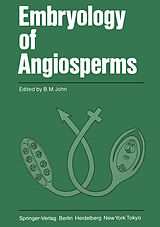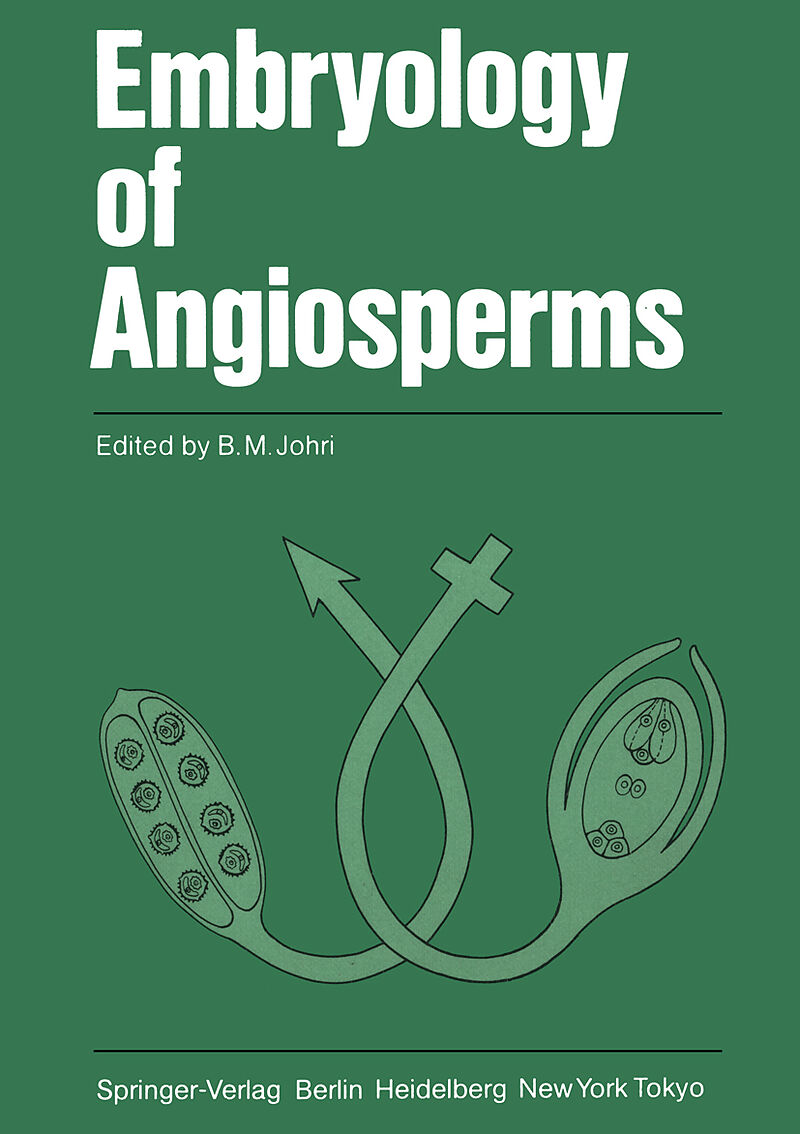Embryology of Angiosperms
Einband:
Kartonierter Einband
EAN:
9783642693045
Untertitel:
Englisch
Herausgeber:
Springer Berlin Heidelberg
Auflage:
Softcover reprint of the original 1st ed. 1984
Anzahl Seiten:
864
Erscheinungsdatum:
18.11.2011
ISBN:
3642693040
Thirty-four years have elapsed since the publication of the late Professor P. Maheshwari's text, An Introduction to the Embryology of Angiosperms, a work which for many years served as an invaluable guide for students and a rich source book for research workerso Various texts dealing with sections of the braad spectrum oftopics encompassed by Maheshwari in his book have appeared in the interim, but a compendious modem work dealing with the whole field has been lacking. This present volume splendidly meets the need, and it is altogether fitting that Professor B. M. lohri, long an associate and close colleague of Professor Maheshwari and himself a prolific contributor to the subject, should have undertaken the task of editing it. When Maheshwari wrote, it was stiIl feasible for one author to handIe the subject, but today even someone with his fine bread th of vision and depth of understanding could not, alone, do it justice. So the effort has to be a collaborative one; and Professor lohri's achievement has been to bring together a team of authoritative collaborators, assign them their responsibilities, and put them to work to produce a text as integrated in its treatment as the diversity of the subject would allow. The product vividly illustrates the advances that have been made in the study of angiosperm reproductive systems in the last 30 years, and the book is surely destined to become the new standard for student and researcher alike.
Inhalt
1 Embryology: Then and Now.- 1.1 Introduction.- 1.2 Techniques to Study Embryology.- 1.3 Embryo Sacs in Anthers.- 1.3.1 Leptomeria.- 1.3.2 Calotis.- 1.3.3 Hyacinthus.- 1.4 Fritillaria Type of Embryo Sac.- 1.5 Unusual Embryological Features in Loranthaceae.- 1.5.1 Ovary-Ovule Complex.- 1.5.2 Embryo Sac.- 1.5.3 Endosperm.- 1.5.4 Embryo.- 1.5.5 Reproductive Calendar in Struthanthus vulgaris.- 1.6 Nutrition of the Ovule and Seed.- 1.6.1 Vascular Supply.- 1.6.2 Haustoria.- 1.6.3 Transfer Cells.- 1.7 Role of Persistent Pollen Tubes.- 1.8 Embryos of Doubtful Origin.- 1.8.1 Antipodal Embryos.- 1.8.2 Endospermal Embryos.- 1.9 Gymnospermous Characters in Angiosperms.- 1.9.1 Tambourissa.- 1.9.2 Butomopsis.- 1.9.3 Paeonia.- 1.10 Future Research.- References.- 2 The Microsporangium.- 2.1 Introduction.- 2.2 Morphology and Structure.- 2.3 Ontogeny.- 2.4 Wall Layers.- 2.4.1 Epidermis.- 2.4.2 Endothecium.- 2.4.3 Middle Layers.- 2.4.4 Tapetum.- 2.5 Ubisch Bodies/Orbicules.- 2.5.1 Origin.- 2.5.2 Relation to Exine Deposition: By-Product.- 2.6 Tapetal Membrane: Structure, Origin, and Significance.- 2.7 Pollenkitt and Tryphine.- 2.8 Sporogenous Tissue: Ultrastructure.- 2.8.1 Cytoplasmic Membranes and Ribosome Population.- 2.8.2 Nucleus.- 2.8.3 Nucleolar Cycle.- 2.8.4 Cytoplasmic Organelles During Meiosis.- 2.8.5 Plasmodesmata and Cytoplasmic Connections.- 2.9 Initiation and Control of Meiosis.- 2.9.1 Duration of Meiosis.- 2.9.2 Synthesis of Callose: Deposition and Significance.- 2.9.3 Cytokinesis.- 2.9.4 Cellulosic Wall of Microspore Mother Cell.- 2.10 Some Unusual Features.- 2.11 Conclusions.- References.- 3 The Ovule.- 3.1 Historical.- 3.2 Ovular Morphology.- 3.3 Ovule Initiation.- 3.4 Nucellus.- 3.5 Megasporogenesis.- 3.6 Integuments.- 3.7 Types of Ovules.- 3.8 Vascular Supply of the Ovule.- 3.9 Special Structures.- 3.10 Ovule Reduction.- 3.11 Concluding Remarks.- References.- 4 The Female Gametophyte.- 4.1 Introduction.- 4.2 Types of Megagametophyte Development.- 4.3 Development of the Megagametophyte.- 4.3.1 The Megaspore.- 4.3.2 The Coenocytic Megagametophyte.- 4.4 The Relation with the Nucellar Tissue.- 4.5 Organization of the Embryo Sac.- 4.5.1 The Synergids.- 4.5.2 The Egg Cell.- 4.5.3 The Central Cell.- 4.5.4 The Antipodal Cells.- 4.6 Female Gametophyte Development.- References.- 5 The Pollen Grain.- 5.1 Introduction.- 5.2 Pollen Structure and Cytochemistry.- 5.2.1 Pollen Shape.- 5.2.2 Pollen Cytology.- 5.2.3 Pollen-wall Structure.- 5.2.4 The Pollen Tube.- 5.2.5 Structural Adaptations of Pollen for Dispersal.- 5.3 Formation of Pollen.- 5.3.1 Cytology of Development.- 5.3.2 The Primexine.- 5.3.3 Establishment of Apertures.- 5.3.4 Exine Differentiation and Maturation.- 5.3.5 Intine Synthesis and Deposition.- 5.3.6 Mechanism of Cohesion in Composite Pollen.- 5.3.7 Pollen Sterility.- 5.4 Pollen Germination and Pistil Interactions.- 5.4.1 Pollen Quality.- 5.4.2 Pollen Germination and Tube Development.- 5.4.3 Diagnostic Landmarks of Pollination.- 5.4.4 Role of Pollen in Fertilization and Seed-setting.- 5.5 Pollen-wall Proteins and Allergens.- 5.6 Conclusions and Future Developments.- References.- 6 Fertilization.- 6.1 Introduction.- 6.2 Stigma and Style.- 6.2.1 Function and Structure of the Stigma.- 6.2.2 The Nature of the Stigma Covering.- 6.2.3 Function and Structure of the Style.- 6.3 Pollen Germination.- 6.3.1 Sticking and Hydration.- 6.3.2 Pollen Tube Formation and Growth.- 6.3.3 The Sperm Cell.- 6.4 Pollen-Pistil Interaction.- 6.4.1 Pollen Recognition, Acceptance, and Rejection.- 6.4.2 Pollen Incompatibility.- 6.4.3 Entry of Pollen Tube into Stigma and Style.- 6.4.4 Pollination Effects.- 6.5 Entrance and Discharge in Embryo Sac.- 6.5.1 Course of the Pollen Tube.- 6.5.2 Entry into the Embryo Sac.- 6.5.3 Growth Through the Filiform Apparatus.- 6.5.4 Entry into the Synergid.- 6.5.5 Transfer of Tube Content.- 6.6 Fusion of Gametes.- 6.6.1 Fusion of Nuclei.- 6.7 The Progamic Phase and Fertilization.- References.- 7 The Endosperm.- 7.1 Introduction.- 7.2 Nuclear Endosperm.- 7.2.1 Wall Formation.- 7.2.2 Cucurbitaceae.- 7.2.3 Leguminosae.- 7.2.4 Palmae.- 7.2.5 Proteaceae.- 7.2.6 Histochemistry and Ultrastructure.- 7.3 Cellular Endosperm.- 7.3.1 Acanthaceae.- 7.3.2 Cyrillaceae.- 7.3.3 Gesneriaceae.- 7.3.4 Icacinaceae.- 7.3.5 Santalaceae.- 7.3.6 Loasaceae.- 7.3.7 Loranthaceae.- 7.3.8 Scrophulariaceae.- 7.3.9 Histochemistry and Ultrastructure.- 7.4 Helobial Endosperm.- 7.4.1 Salient Features in Monocotyledons.- 7.4.2 Histochemistry and Ultrastructure.- 7.5 Ruminate Endosperm.- 7.6 Central Cell.- 7.6.1 Central Cell Cytoplasm.- 7.6.2 Central Cell Nucleus.- 7.6.3 Covering of the Central Cell.- 7.7 Wall Formation in Endosperm.- 7.8 Cytology of the Endosperm.- 7.9 Reserve Materials in Developing Endosperm.- 7.9.1 Protein Bodies.- 7.9.2 Starch.- 7.10 Embryo-Endosperm Relationship.- 7.11 Incorporation of Nucellus and Integument in Endosperm Formation.- 7.12 Conclusions and Prospects.- References.- 8 The Embryo.- 8.1 Historical.- 8.2 Zygote.- 8.2.1 Structure and Composition.- 8.2.2 Size Adjustments.- 8.2.3 Polarity.- 8.3 Early Embryogenesis.- 8.3.1 Cell Patterns.- 8.3.2 Tetrad, Quadrant, and Octant Proembryos.- 8.3.3 Stages Leading to Mature Embryo.- 8.4 Classification Based on Early Development of the Embryo.- 8.4.1 Systems Suggested by Schnarf and Johansen.- 8.4.2 System Suggested by Souèges.- 8.4.3 Other Systems of Classification.- 8.5 Differentiation in Embryo.- 8.6 Dicot and Monocot Embryo.- 8.7 The Grass Embryo.- 8.8 The Embryo in Palms.- 8.9 Ultrastructural and Cytochemical Aspects.- 8.10 Suspensor: Structure and Function.- 8.11 Deviations from Usual Development.- 8.11.1 Embryogeny in Paeonia.- 8.11.2 Embryos Devoid of Organs.- 8.11.3 Chimeral Embryos.- 8.12 Concluding Remarks.- References.- 9 Polyembryony.- 9.1 Introduction.- 9.2 Classification.- 9.2.1 Simple Polyembryony.- 9.2.2 Multiple Polyembryony.- 9.3 Nucellar Polyembryony.- 9.3.1 Rutaceae.- 9.3.2 Anacardiaceae.- 9.3.3 Myrtaceae.- 9.3.4 Cactaceae.- 9.3.5 Orchidaceae.- 9.4 Integumentary Polyembryony.- 9.4.1 Endothelial Polyembryony.- 9.5 Zygotic and Suspensor Polyembryony.- 9.5.1 Zygotic Polyembryony.- 9.5.2 Suspensor Polyembryony.- 9.6 Synergid Polyembryony.- 9.6.1 Twins and Triplets.- 9.7 Polyembryony in Hybrids.- 9.8 Causes of Polyembryony.- 9.9 Induction of Polyembryony.- 9.10 Utilization of Plural Embryos.- References.- 10 Gametophytic Apomixis.- 10.1 Introduction.- 10.1.1 Definitions.- 10.1.2 Synonyms.- 10.1.3 Remarks on Terminology.- 10.2 E…

Leider konnten wir für diesen Artikel keine Preise ermitteln ...
billigbuch.ch sucht jetzt für Sie die besten Angebote ...
Die aktuellen Verkaufspreise von 5 Onlineshops werden in Realtime abgefragt.
Sie können das gewünschte Produkt anschliessend direkt beim Anbieter Ihrer Wahl bestellen.
Loading...
Die aktuellen Verkaufspreise von 5 Onlineshops werden in Realtime abgefragt.
Sie können das gewünschte Produkt anschliessend direkt beim Anbieter Ihrer Wahl bestellen.
| # | Onlineshop | Preis CHF | Versand CHF | Total CHF | ||
|---|---|---|---|---|---|---|
| 1 | Seller | 0.00 | 0.00 | 0.00 |
